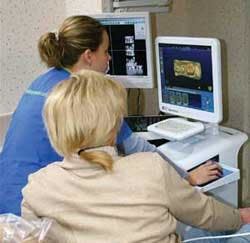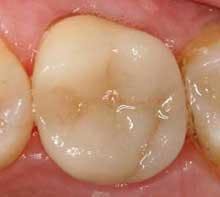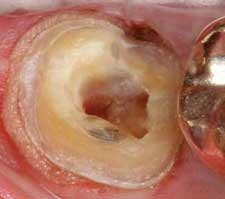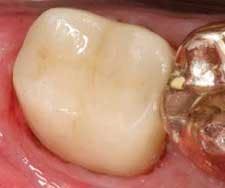Wowing the patient with chairside CAD/CAM
Wow! That's the response we get from our patients every time they observe the design of their new chairside CAD/CAM crown. This kind of "WOW" factor is something we haven't seen in dentistry in a long time … if ever! Patients absolutely love it. They tell their friends. They tell their families.They tell their co-workers. More importantly, they refer their friends, families, and co-workers.
mckinneydentist.com
Our practice is in McKinney, Texas (population 85,000), about 30 miles north of Dallas. McKinney is one of the fastest growing cities in the state. Along with my partners, Dr. Matthew Markham, Dr. Jeff Lynch, and Dr. Britt Bostick, we have one of the most productive dental practices in North America. We are a bread-and-butter general dental practice serving the entire community with outstanding dentistry. The majority of our dentistry is single-tooth or quadrant dentistry. We have mmoe than 40 team members, including our own full-service in-house crown and bridge laboratory. Our existing patient base is over 50,000, and we continue to grow at a rate of 250 new patients a month.
Customer service is not something we take lightly; in fact, we are constantly looking for new ways to provide for our patients. The latest advancement in our practice has been the introduction of chairside CAD/CAM dentistry — same-day crowns/inlays/onlays — with the E4D Dentist® System from D4D Technologies, LLC.
CAD/CAM
To say the future of dentistry is in CAD/CAM is an understatement. It's here now and it's here to stay. Computer-aided design/computer-aided manufacturing technology for dentistry is allowing us to provide even better care for patients.
When we were considering adding chairside CAD/CAM dentistry to our office, our one requirement was that the quality of the final restoration be equal to or better than what we were already receiving via the laboratory. We are very fortunate in that we have our own in-house crown and bridge laboratory with skilled dental technicians, so we were able to compare apples to apples: lab-fabricated pressed IPS Empress to IPS Empress CAD (Ivoclar Vivadent) milled restorations. In addition, we compared lab-fabricated Sculpture Plus® (Pentron Clinical Technologies, LLC ) to chairside-fabricated inlays and onlays using Paradigm™ MZ100 for CEREC® (3M ESPE) milled using the E4D Dentist System. What we found were nearly identical restorations in fit, esthetics, and function.
Marginal integrity
As with all restorations, marginal integrity is critical to the long-term success of the restoration. The replication of the tooth margin in traditional lab restorations is directly affected by various impression materials, techniques, shrinkage, or expansion of both the impression material and/or dental stone, the amount of time elapsed between the impression and the model work, the accuracy of the die trim, and the expansion and/or contraction associated with the final casting of the restoration.
The scan
In contrast, the accuracy of CAD/CAM restorations depends on the scanner's ability to visualize the margin. A true laser scanner/digitizer takes precise digital images of the prep, including the margin, the undercuts, the contours, the adjacent dentition, and the gingiva. It captures hundreds of thousands of points of reference with each image, and then utilizes a million data points to create an exact replica (virtual model, if you will) of the prepared tooth and neighboring dentition. I don't use powder, although the system can scan with or without a reflecting agent, so I have no distortion. There is no guess work. With all other CAD/CAM capturing devices, you create a digital stone model with which to build your restoration. ICE works differently. It takes actual pictures of the prepared tooth, adjacent teeth, and gingiva. As you take successive pictures, the software builds a library of images which it "wraps" around the virtual model. You view your preparation as a three-dimensional photograph of the actual tooth that shows hard and soft tissue, the thickness of the enamel, and most importantly, well-defined margin edges. With a near exact digital replication of your prepared tooth, and more importantly, the precise margin location, the end result is a predictable margin selection process.
The design
Once your margin is selected, the fun begins — designing your new restoration. What could take hours or sometimes days in a lab, takes minutes on the computer. The CAD portion of the process begins — Computer-Aided Design. This is where we like to get the patient involved with the process — we set them up in the chair so they can watch their restoration take shape right before their eyes.
Sometimes, we feel guilty because E4D's Autogenesis™ feature makes creation of the restoration look so simple. It literally works with the click of a button. It does almost all of the work for us. This feature doesn't choose from other people's dental anatomy or a database of representative teeth; instead, it customizes a restoration for our patient's specific anatomical needs. How would you like having Lee Culp, CDT, design all your restorations? That's what we get every time we design a CAD/CAM restoration.
This technology gives you a great proposal based on Lee Culp's specifications. One click of a button places the restoration on your digital prep, positions it, and shapes the initial tooth template to match central grooves, cusp heights, marginal ridges of the neighboring teeth, contacts, embrasures, and emergence profile. This creates a starting point that many dentists don't even feel the need to edit. But you still have the ability to easily change any aspect to better fit each patient's particular needs.
The final restoration
This is where the CAM part of the equation is introduced — Computer-Aided Manufacturing. Once the restoration is designed, it is sent wirelessly to the Milling Center. Your material of choice is placed in the unit. The spindles in the milling unit "machine" both sides of the restoration simultaneously, and in about 15 to 20 minutes, your restoration is complete. It is then tried in the mouth to verify marginal integrity and contacts, and to carefully check occlusion. Usually, it is spot-on perfect … just like you designed it!
Stain and glaze
As with similar laboratory restorations, you can make them look as detailed or as customized as you'd like. We stain and glaze all of our ceramic restorations. Another huge plus in doing the staining and glazing process chairside is that you actually can "custom stain" each restoration to match the patient's exact shade. For difficult shades or areas in a high esthetic zone, this is invaluable. You have the restoration and the patient right there for just the right amount of color. The staining and glazing will add about 15 minutes to 20 minutes to the appointment time, which gives me an opportunity to complete any remaining restorative work, if necessary. Once a CAD/CAM restoration is properly stained and glazed, it is virtually impossible to distinguish it from a traditional laboratory-fabricated restoration.
Chairside Dental DesignerTM
E4D University offers a Chairside Dental Designer program where assistants can go to gain advanced education and training in scanning, designing, and milling CAD/CAM restorations. One of the best is my dental assistant, Sherri White, who has been working chairside with me for almost 10 years. She is a very skilled assistant and has made it her focus to excel in CAD/CAM dentistry. She now works with E4D, training other dental professionals in the art and science of digital dental design and providing a high quality patient experience.
From a profitablility standpoint, using a dental auxiliary to his or her maximum capabilities is critical. My assistant supplements scans, designs, mills, and can stain and glaze each restoration. This allows me to be more productive in other areas. In the majority of cases, if no other dental work is needed for a patient once I complete the tooth preparation, I return in about an hour for the final cementation.
Endodontics and CAD/CAM
This has become one of the most profitable procedures in my practice: same-day root canal, build-up, and crown! This is really a wonderful service to the patient and can usually be completed in about two hours from start to finish. The sequence is as follows:
First, prep the indicated tooth. Second, scan the prepped tooth. Then, while my assistant is designing and milling the final restoration, I treat the tooth endodontically.
Once the restoration has finished milling, we confirm contacts, margins, and occlusion. It is then stained and glazed while I complete the root canal. Before cementation, we build up the core of the tooth with a dual-cure flowable core material. Obviously, operatory efficiency and endodontic experience play a huge role in this service, but what a service to the patient!
A great fit!
Clinically speaking, in my experience, the quality of both chairside CAD/CAM-fabricated restorations and laboratory-fabricated restorations are imperceptible. But when I factor in all aspects of both procedures including time, cost, labor, and the "WOW" factor to the patient, the chairside CAD/CAM restoration can't be beat for single unit or quadrant dentistry. In addition, the ultimate benefit to a practice is the phenomenal patient satisfaction and appreciation. This is true customer service.
Patients appreciate:
- Being involved in their restoration design
- Not having to return for a second visit
- Not having to be anesthetized again
- Not having to take off work or take a vacation day
- Not having to wear a temporary crown for several weeks
- Not having potential sensitivity from temporary crowns
If you ask me if chairside CAD/CAM restorations "fit," the answer is a resounding yes! They fit my clinical expectations, my modern dental practice, and our patients' modern lifestyles and expectations.
Just last week, we had a patient who was scheduled to start chemotherapy the following day. She had sheared the lingual cusp off of a premolar, and her oncologist did not want her in any provisional restoration while undergoing chemotherapy. Within an hour and a half, we completed her dental treatment and she followed through with her scheduled chemotherapy. For her, it was one less thing to worry about. For us, she was one more satisfied patient.
Marvin Berlin, DDS, is the heart and soul of mckinneydentist.com. He graduated from the University of Texas in 1984 with a Bachelor of Business Administration degree in management and marketing. He completed his doctorate at Baylor College of Dentistry in Dallas.








